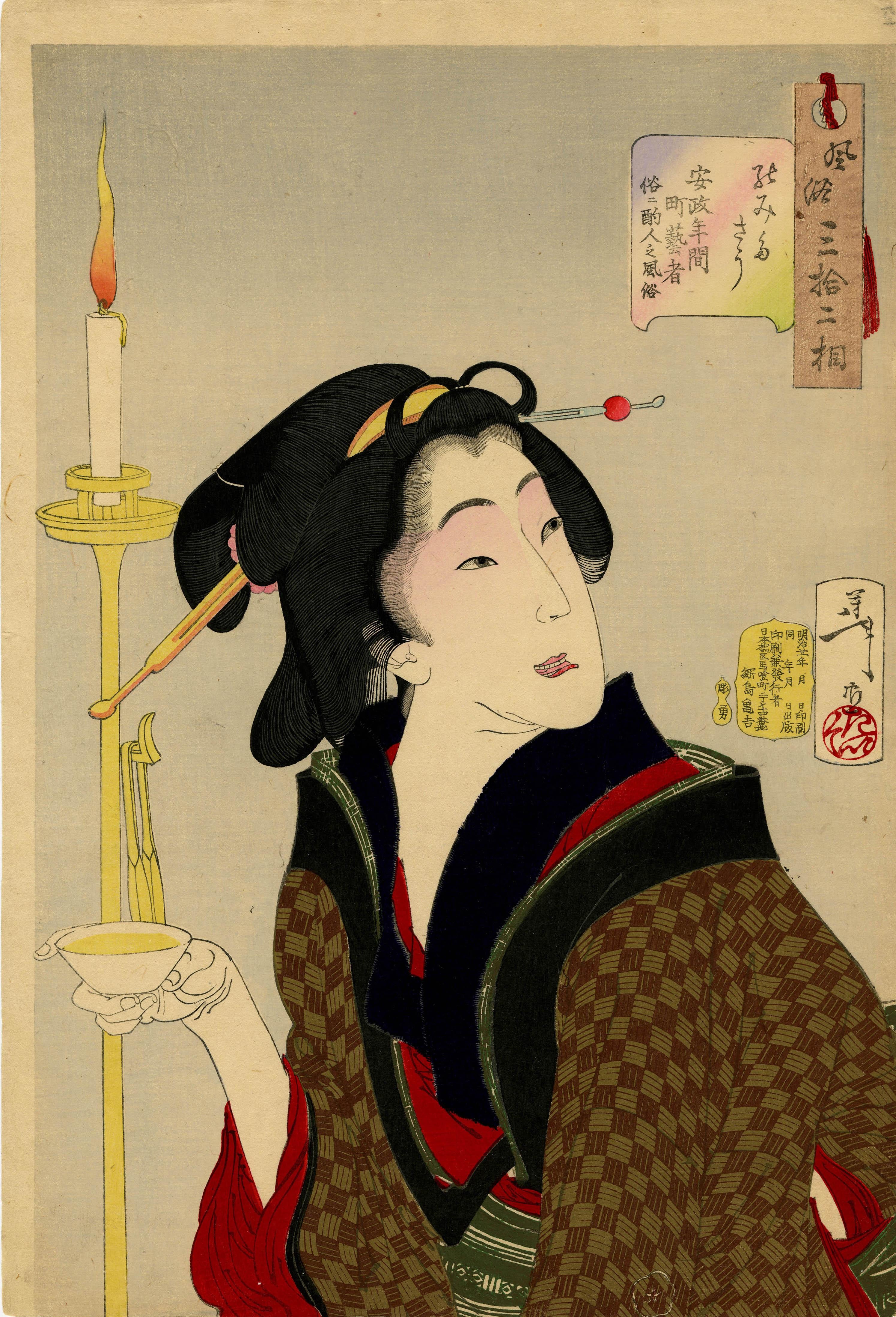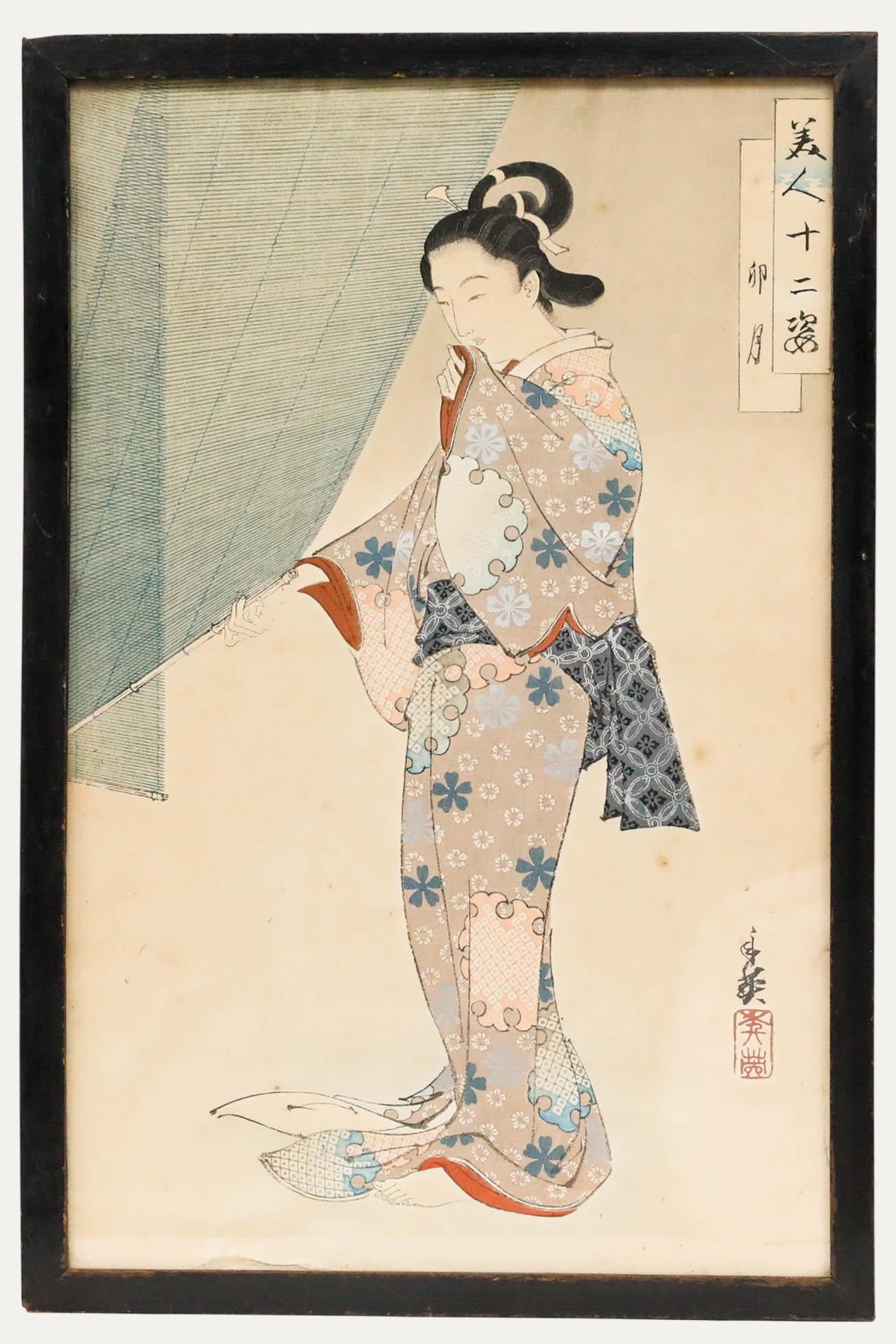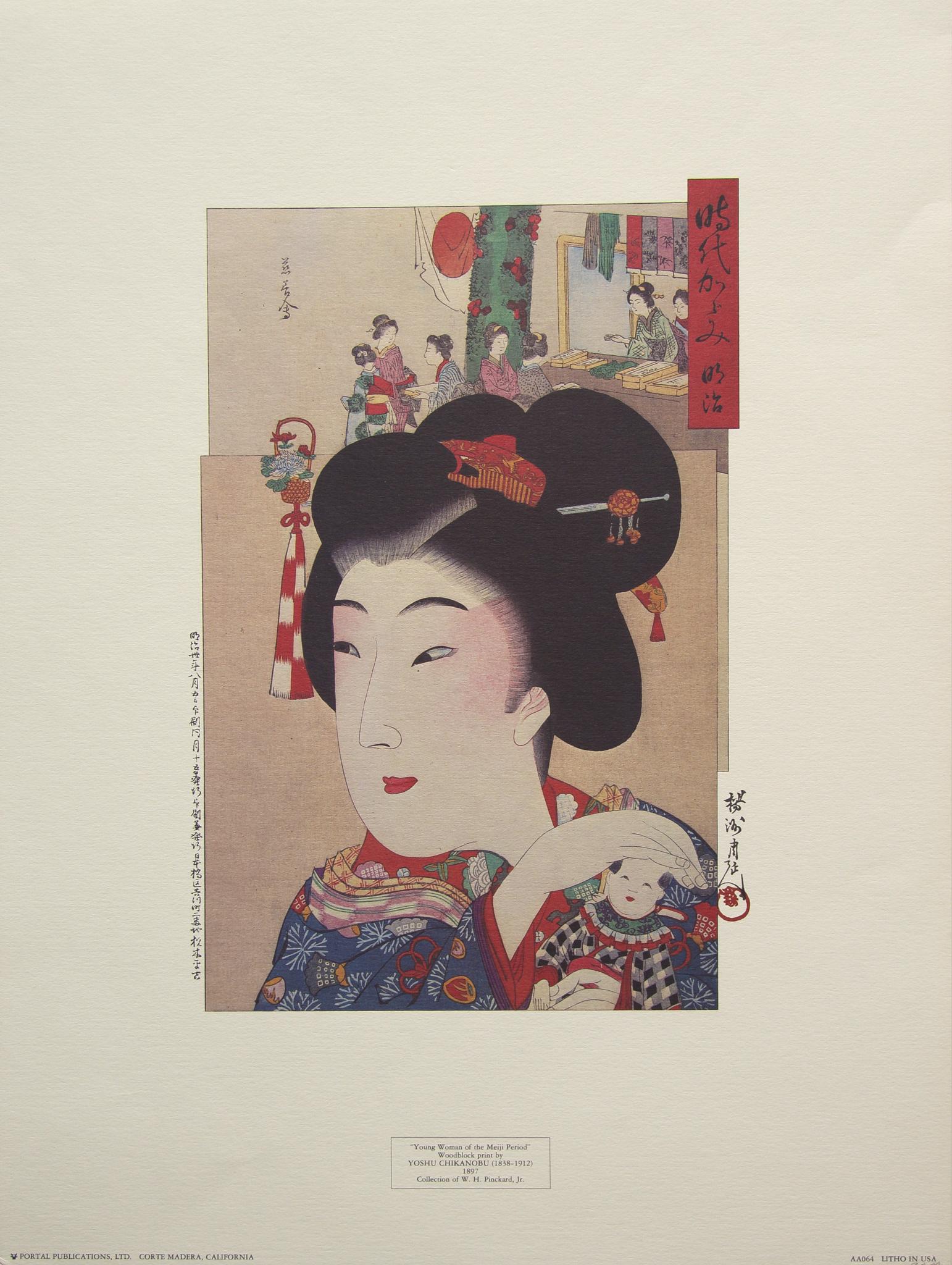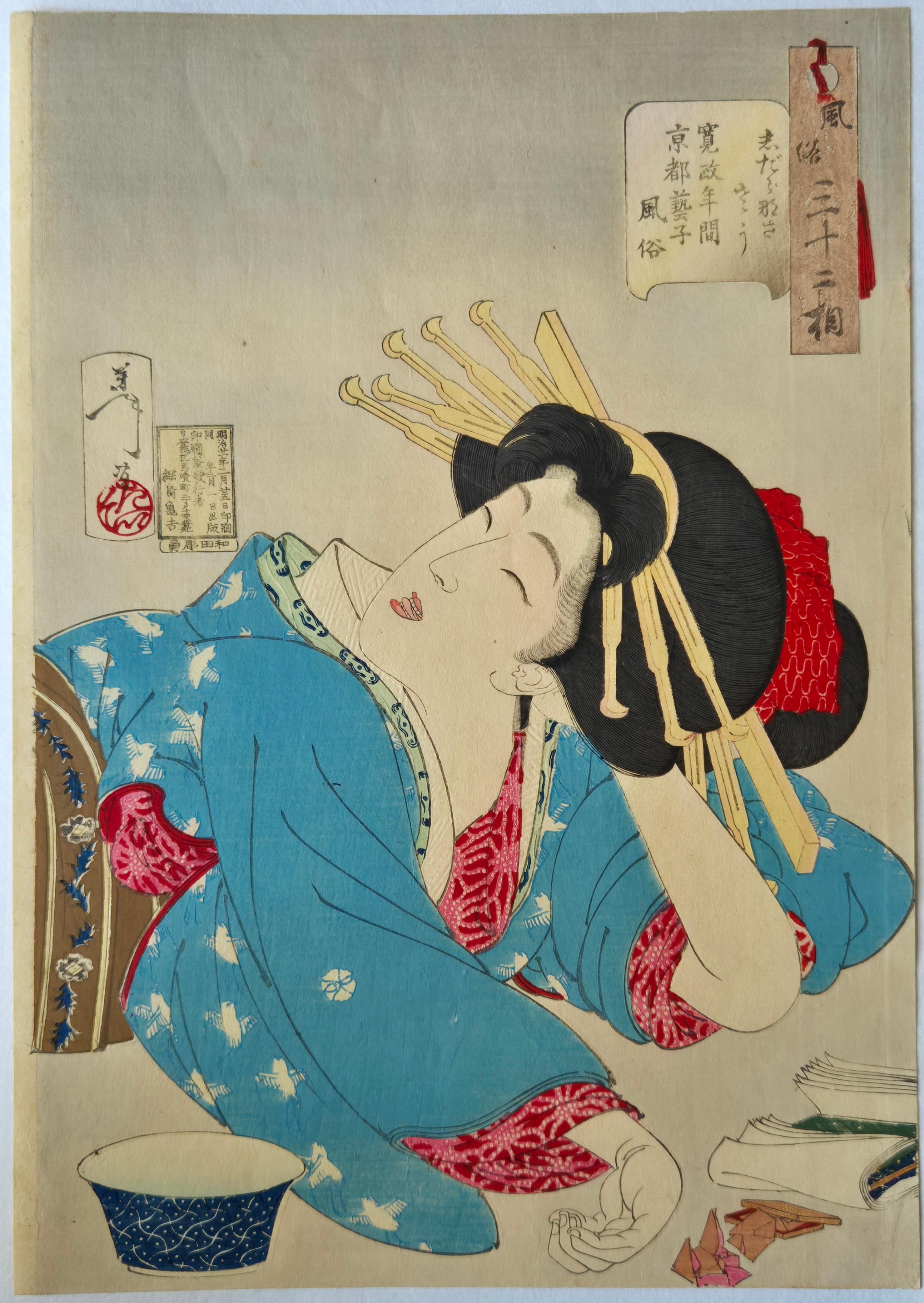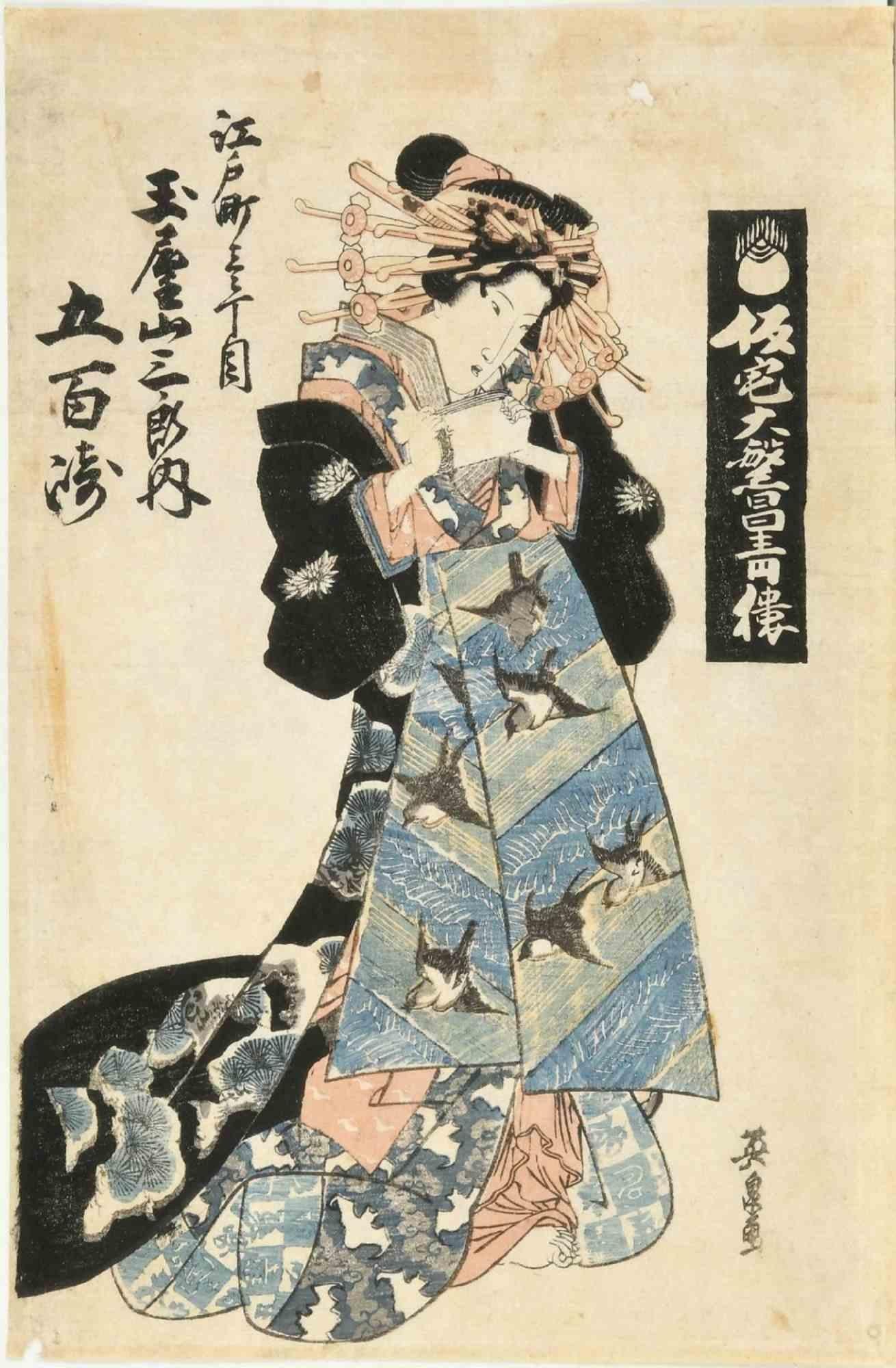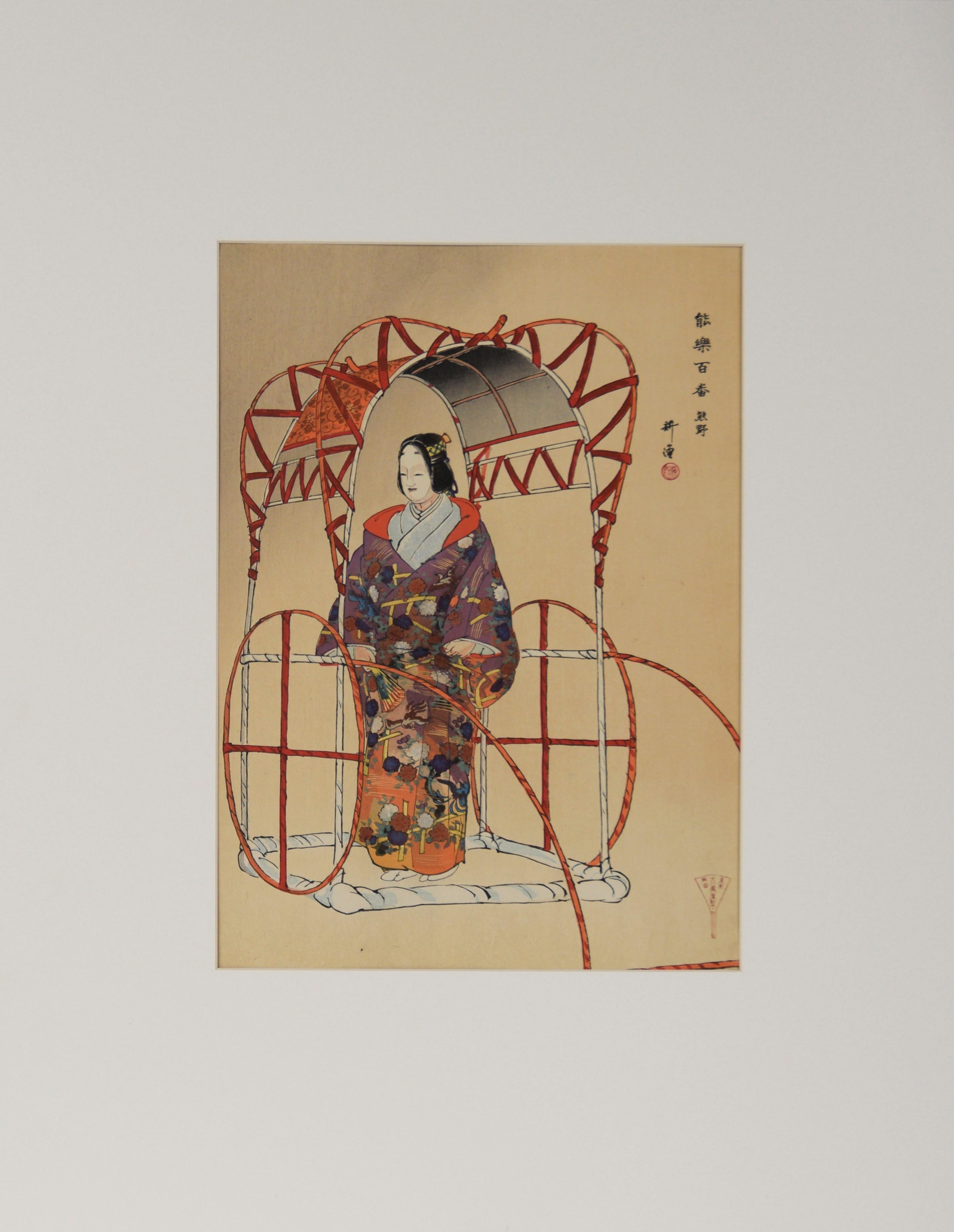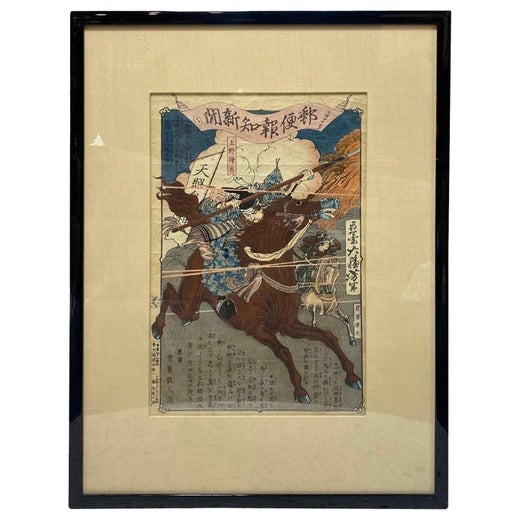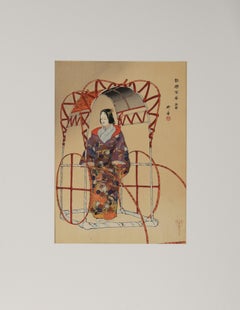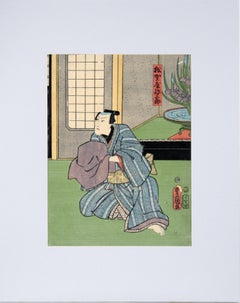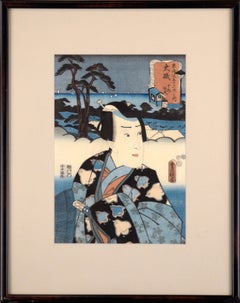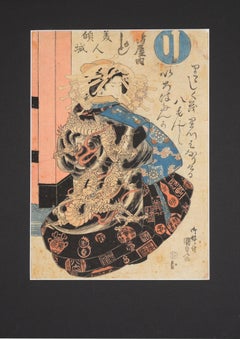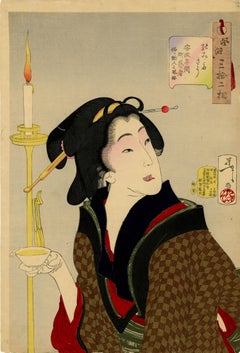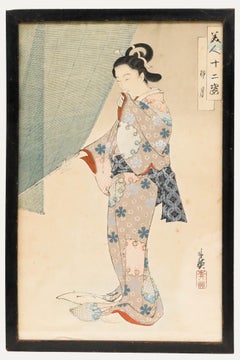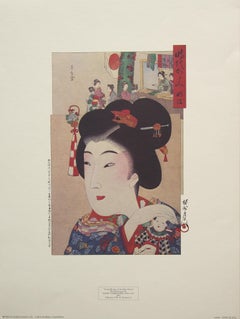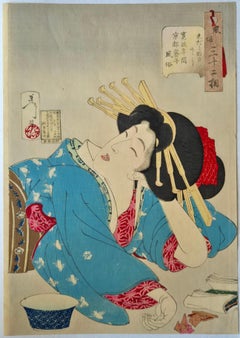Items Similar to "Thirsty: the appearance of a town geisha in the Ansei era" - Woodblock on Paper
Want more images or videos?
Request additional images or videos from the seller
1 of 13
Tsukioka Yoshitoshi"Thirsty: the appearance of a town geisha in the Ansei era" - Woodblock on Paper1888
1888
$950
£719.81
€825.92
CA$1,336.80
A$1,469.51
CHF 772.31
MX$17,845.26
NOK 9,634.37
SEK 9,127.89
DKK 6,164.05
About the Item
"Thirsty: the appearance of a town geisha in the Ansei era" - Woodblock on Paper
From the series "Thirty-two Aspects of Customs and Manners" (Fuzoku sanjuniso)
Lively woodblock of a geisha in the Amsei era by Tsukioka Yoshitoshi (Japanese, 1839-1892). A woman is holding a sake cup, looking to the viewer's right. There is a tall candlestick to the left of the composition. The geisha is dressed in boldly colored clothing, with rich black, brown, and red patterns. The title "town geisha" suggests the lower status of this plainly dressed young woman. Rather than dancing and entertaining, she is mostly assigned to serving drinks. In this scene she is on her knees turning left towards a customer with a cup of sake in her hand. Her face is slightly flushed with pink around the eyes, suggesting that she enjoys drinking sake herself, as she smiles cheerfully. A charming design, finely detailed.
Artist's signature, chop, title, and description in the upper right corner.
Presented in a black frame with a cream mat.
Frame size: 20"H x 14"W
Paper size: 14.13"H x 9.5"W
About the series: Yoshitoshi's finest series of bijin-ga, or pictures of beautiful women, Thirty-two Aspects of Customs and Manners features illustrations of beauties in a lighthearted reference to the thirty-two notable features of Buddha. The women depicted come from all social classes, representing beauties from the late 18th century through Yoshitoshi's own time.
Each design captures a woman in a scene from daily life, realistically and sensitively portrayed as individuals rather than idealized figures. Sumptuous fabrics are beautifully rendered, and hairstyles and facial features are drawn with the most delicate of lines. The series was beautifully printed using the most costly techniques, such as delicate bokashi shading, embossing, and burnishing, creating some of the finest prints of the Meiji era.
Thirty-two Aspects proved popular with the public when published in 1888, and has been appreciated by viewers and collectors ever since. Designs in this fantastic series are some of the most highly sought after woodblocks of the Meiji era, and are certainly considered great masterworks of Yoshitoshi's career.
--
Born in Edo in 1839, Tsukioka Yoshitoshi (Japanese, 1839-1892) became a student of noted woodblock artist Kuniyoshi in 1850, at the age of eleven. His first print, a triptych of a historical naval battle, was issued just three years later. After Kuniyoshi's death in 1861, Yoshitoshi earned his living designing prints of kabuki actors.
The 1860s were a time of increasing political unrest in Japan. A witness to the Battle of Ueno, a massacre of the shogun's supporters by imperial forces in 1868, Yoshitoshi's bloody battle prints during this period reflect the violence and upheaval of the time.
Yoshitoshi experienced some commercial success in the late 1860s, earning popularity designing prints for newspapers, but in 1871 he fell into a deep depression, living in poverty and unable to work. The year 1873 marked a rebirth for Yoshitoshi, as he emerged from his illness and began using a new go or artist name: Taiso, which means great resurrection. The following decades would see the production of his greatest work.
Considered his masterwork, Yoshitoshi's series One Hundred Aspects of the Moon was published from 1885-1892. These quiet and reflective prints, beautifully composed and drawn, feature subjects from traditional Japanese and Chinese history and legend, rendered with great sensitivity and emotion. Yoshitoshi's other important series from this period include New Forms of Thirty-six Ghosts and Thirty-two Aspects of Customs and Manners.
Sadly, Yoshitoshi's mental illness returned, and he was hospitalized in 1891. He continued to work intermittently, but died of a cerebral hemorrhage in 1892 at the age of fifty-three.
Yoshitoshi was the most influential woodblock print artist of Meiji era Japan. His prints shimmer with energy and bring to life the tales of ancient Japan: the downfall of the once mighty, untouchable beauty, military conquests, and slices of everyday life. A consummate draftsman and imaginative designer, Yoshitoshi brought creativity, emotion, and elegance to images that continue to resonate with audiences today.
- Creator:Tsukioka Yoshitoshi (1839 - 1892, Japanese)
- Creation Year:1888
- Dimensions:Height: 20 in (50.8 cm)Width: 14 in (35.56 cm)Depth: 0.75 in (1.91 cm)
- Medium:
- Movement & Style:
- Period:
- Condition:Tonal ageing to paper, as expected. Trimmed slightly. Frame has some wear.
- Gallery Location:Soquel, CA
- Reference Number:Seller: DBH76101stDibs: LU54211554732
Tsukioka Yoshitoshi
Born in Edo in 1839, Yoshitoshi became a student of noted woodblock artist Kuniyoshi in 1850, at the age of eleven. His first print, a triptych of a historical naval battle, was issued just three years later. After Kuniyoshi's death in 1861, Yoshitoshi earned his living designing prints of kabuki actors. The 1860s were a time of increasing political unrest in Japan. A witness to the Battle of Ueno, a massacre of the shogun's supporters by imperial forces in 1868, Yoshitoshi's bloody battle prints during this period reflect the violence and upheaval of the time. Yoshitoshi experienced some commercial success in the late 1860s, earning popularity designing prints for newspapers, but in 1871 he fell into a deep depression, living in poverty and unable to work. The year 1873 marked a rebirth for Yoshitoshi, as he emerged from his illness and began using a new go or artist name: Taiso, which means great resurrection. The following decades would see the production of his greatest work. Considered his masterwork, Yoshitoshi's series One Hundred Aspects of the Moon was published from 1885-1892. These quiet and reflective prints, beautifully composed and drawn, feature subjects from traditional Japanese and Chinese history and legend, rendered with great sensitivity and emotion. Yoshitoshi's other important series from this period include New Forms of Thirty-six Ghosts and Thirty-two Aspects of Customs and Manners. Sadly, Yoshitoshi's mental illness returned, and he was hospitalized in 1891. He continued to work intermittently, but died of a cerebral hemorrhage in 1892 at the age of fifty-three. Yoshitoshi was the most influential woodblock print artist of Meiji era Japan. His prints shimmer with energy and bring to life the tales of ancient Japan: the downfall of the once mighty, untouchable beauty, military conquests, and slices of everyday life. A consummate draftsman and imaginative designer, Yoshitoshi brought creativity, emotion, and elegance to images that continue to resonate with audiences today.
About the Seller
5.0
Platinum Seller
Premium sellers with a 4.7+ rating and 24-hour response times
Established in 1986
1stDibs seller since 2014
3,000 sales on 1stDibs
Typical response time: <1 hour
- ShippingRetrieving quote...Shipping from: Soquel, CA
- Return Policy
Authenticity Guarantee
In the unlikely event there’s an issue with an item’s authenticity, contact us within 1 year for a full refund. DetailsMoney-Back Guarantee
If your item is not as described, is damaged in transit, or does not arrive, contact us within 7 days for a full refund. Details24-Hour Cancellation
You have a 24-hour grace period in which to reconsider your purchase, with no questions asked.Vetted Professional Sellers
Our world-class sellers must adhere to strict standards for service and quality, maintaining the integrity of our listings.Price-Match Guarantee
If you find that a seller listed the same item for a lower price elsewhere, we’ll match it.Trusted Global Delivery
Our best-in-class carrier network provides specialized shipping options worldwide, including custom delivery.More From This Seller
View All"Pictures Of Noh" - 1922 Original Japanese Woodblock Print
Located in Soquel, CA
"Pictures Of Noh" - 1922 Original Japanese Woodblock Print
Original Japanese woodblock print by Tsukioka Kogyo (Japanese, 1869-1927...
Category
1920s Edo Figurative Prints
Materials
Ink, Rice Paper, Woodcut
"Sun Saburo Matsugaya" - Mid 19th Century Figurative Japanese Woodblock Print
By Utagawa Kunisada (Toyokuni III)
Located in Soquel, CA
"Sun Saburo Matsugaya" - Mid 19th Century Figurative Japanese Woodblock Print
Beautiful mid 19th century figural Japanese woodblock print of a seated man with lilies in the background by Utagawa Toyokuni III (Kunisada) (Japanese, 1786-1864/5). Artist's chop is in the lower right corner of the piece. The actor is Magosaburo Matsugaya from the play "Katakiuchi Rumors"
Presented in a new grey-blue mat with foamcore backing.
Mat size: 21"H x 16"W
Paper size: 14"H x 9.75"W
During his lifetime Kunisada Utagawa...
Category
1850s Edo Figurative Prints
Materials
Paper, Ink, Woodcut
"Juro Sukenari, Station #9: Oiso", Mid 19th Century Japanese Ukiyo-e Woodblock
By Utagawa Kunisada (Toyokuni III)
Located in Soquel, CA
Beautiful mid 19th century Japanese woodblock print of a samurai by Utagawa Toyokuni III (Kunisada) (Japanese, 1786-1864/5). This piece is from a series of "The 53 Stations of the To...
Category
1860s Edo Figurative Prints
Materials
Paper, Ink
The Courtesan Kashiwagi and the Kamuro Wakano - Japanese Woodblock Print
By Utagawa Kunisada (Toyokuni III)
Located in Soquel, CA
The Courtesan Kashiwagi and the Kamuro Wakano - Japanese Woodblock Print
Original Toyokuni III/Kunisada (Japanese, 1786 - 1864) Japanese Woodblock Print
"The Courtesan Kashiwagi and...
Category
1820s Realist Figurative Prints
Materials
Printer's Ink, Rice Paper, Woodcut
Two Actors - Japanese Woodblock by Chikanobu Yoshu
By Toyohara Chikanobu
Located in Soquel, CA
Two Actors - Japanese Woodblock by Toyohara Chikanobu (豊原周延, 1838–1912), better known to his contemporaries as Yōshū Chikanobu (楊洲周延).
Colorful and expressive court scene. Two actors...
Category
1890s Edo Landscape Prints
Materials
Ink, Rice Paper, Woodcut
$700 Sale Price
20% Off
Annual Events for Young Murasaki (July) - Tales of Genji - Japanese Woodblock
By Utagawa Kunisada (Toyokuni III)
Located in Soquel, CA
Annual Events for Young Murasaki (July) - Tales of Genji - Japanese Woodblock
Rightmost panel a triptych, depicting monthly events for Wakamurasaki (Young Murasaki). This is the month of July. There appears to be a lesson taking place, possibly for writing or poetry.
Artist: Toyokuni III/Kunisada (1786 - 1864)
Publisher: Ebisu-ya Shoshichist
Presented in a new blue mat.
Mat size: 19"H x 13"W
Paper size: 14.5"H x 10"W
Commentary on the triptych:
In the Edo period, Tanabata was designated as one of the five seasonal festivals, and became an annual event for the imperial court, aristocrats, and samurai families, and gradually came to be celebrated by the general public. Its origins are said to be a combination of the Kikoden festival, which originated from the Chinese legend of Altair and the Weaver Girl, and Japan's ancient Tanabata women's faith. Ink is ground with dew that has accumulated on potato leaves, poems and wishes are written on five colored strips of paper, which are then hung on bamboo branches to celebrate the two stars that meet once a year. Although the illustration is a Genji painting...
Category
1850s Realist Figurative Prints
Materials
Printer's Ink, Rice Paper, Woodcut
You May Also Like
Thirsty: The Appearance of a Town Geisha - a So-Called Wine-Server - in the Anse
By Taiso Yoshitoshi
Located in Fairlawn, OH
Thirsty: The Appearance of a Town Geisha - a So-Called Wine-Server - in the Ansei Era
Color woodcut, 1888
Signed; Seal: Taiso (see photo)
Plate 22 from the series "Thirty-two Aspects...
Category
1880s Showa Figurative Prints
Materials
Woodcut
Toshihide Migita (1863-1925) - Japanese Woodblock, Geisha
By Migita Toshihide
Located in Corsham, GB
This ukiyo-e print depicts a geisha elegantly adorned in traditional dress as she lifts the blinds. The work is from the series "Bijin Juni-shi" (The Twelve Figures of the Beauties) ...
Category
Late 19th Century Portrait Prints
Materials
Woodcut
"Young Woman of the Meiji" by Yoshu Chikanobu, Lithographic Print.
By Yoshu Chikanobu
Located in Chesterfield, MI
Published by Portal Publications.
Printed in USA
Good Condition
24 x 18
Category
20th Century Portrait Prints
Materials
Lithograph
$120 Sale Price
20% Off
Tsukioka Yoshitoshi -- Looks Slovenly', Mannerisms of a Kyoto Geisha
By Tsukioka Yoshitoshi
Located in BRUCE, ACT
Tsukioka Yoshitoshi
Looks Slovenly', Mannerisms of a Kyoto Geisha from the Kansei Period from Thirty-Two Daily Scenes (風俗三十二相), 1888
Woodblock print
Oban
The image depicts a geisha...
Category
1880s Prints and Multiples
Materials
Woodcut
Courtesan - Woodcut by Keisai Eisen - 1830
By Keisai Eisen
Located in Roma, IT
Courtesan is an original modern artwork realized by Keisai Eisen in the first half of the 19th Century.
Signed and inscribed on plate.
Total dimension...
Category
1830s Modern Portrait Prints
Materials
Paper, Woodcut
The High - Ranking Courtesan - Woodcut Print by Keisai Eisen - 1820s
By Keisai Eisen
Located in Roma, IT
The high-ranking courtesan Shiragiku Bijinga is an original modern artwork realized by Keisai Eisen in the 1821-23.
Woodcut Print Oban Format.
From the ...
Category
19th Century Modern Figurative Prints
Materials
Woodcut
$520 Sale Price
40% Off
More Ways To Browse
Antique Geisha
Meiji Woodblock
Sake Cup
Geisha Woodblock
Signed Chagall Print
Signed Prints By Dali
Simbari Lithograph
Star Legend
Sumo Print
Used Pacemaker
William Temple
Alexej Von Jawlensky
Alice In Wonderland Prints Vintage
Barbizon Etchings
Chagall Flowers
Chagall Galerie Maeght
Chagall Lithograph Ruth Boaz
Chagall Ruth And Boaz
